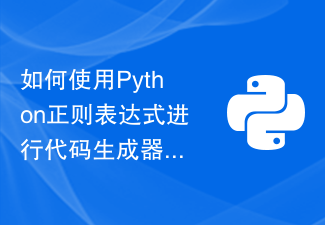With the rapid development of Web development, PHP has become one of the main programming languages for Web development. Many web developers use PHP to write their applications because it has advantages such as easy to learn, easy to write, cross-platform, etc. However, for large PHP projects, writing all the code by hand is very time-consuming and laborious. After all, we want to complete projects in a more efficient way and quickly develop applications that meet our customers' requirements.
Therefore, we can use PHP automatic code generation tools to speed up the development process and help us generate model, view, controller and other code files. This is especially useful for developers who want to develop applications quickly. This article will introduce how to use automatic code generation tools in PHP development.
- Choose the automatic generation tool that suits you
According to our needs, we can choose the one that suits us from multiple automatic generation tools. For example: Laravel, Symfony, CodeIgniter, Yii, etc. Laravel and Symfony are commonly used frameworks in PHP development and provide many automatic generation tools, while CodeIgniter and Yii are considered to be more performant frameworks. Therefore, we should choose the framework and automatic generation tools that suit us based on project needs. - Install and configure automatic generation tools
After selecting the automatic generation tools that suit you, we need to install and configure these tools. For Laravel and Symfony, we can use their command line tools (composer) to install and configure. In CodeIgniter and Yii, we need to copy the generator and template files so that they can run in our application. These steps can be found in the framework's documentation and are generally relatively simple. Of course, the premise is that we have installed PHP according to the requirements of the corresponding framework. - Generate code
Once we have installed and configured the automatic generation tool, we can start generating code. When using Laravel or Symfony, we can use their command line tools to generate code files. Therefore, we need to enter the corresponding commands on the command line. For example, in Laravel, we can use commands such as make:model, make:controller and make:view to generate model, view and controller files. This process is very simple, we only need to ensure that the files are in the specified directory according to such commands.
If we are using a framework such as CodeIgniter or Yii, we need to use an automatic generation script to generate code files. Generators typically use template files to generate code. We can customize template files to meet specific needs. When using the code generator, we need to provide relevant commands and options to correctly generate code files.
- Custom code generator
In some cases, we need to customize the code generator to meet specific needs. At this time we need to write a script to generate a specific code file template. Different frameworks may require different custom code generators, depending on our needs. - Getting started
Once we have generated the code files, we can use them to develop our application. We can use automatically generated code files to create models, controllers, and views to develop our applications faster.
Summary
Using automatic code generation tools in PHP development can greatly improve our development efficiency. We can choose the framework and automatic generation tools that suit us according to our needs, then install and configure these tools, and generate the required code files. Of course, we can also use custom code generators to meet specific needs. According to the actual situation, choosing the appropriate automatic code generation tool to assist development can make Web development more efficient and simpler.
The above is the detailed content of How to use automatic code generation tools in PHP development. For more information, please follow other related articles on the PHP Chinese website!
 PHP开发中如何使用代码自动生成工具Jun 27, 2023 pm 02:30 PM
PHP开发中如何使用代码自动生成工具Jun 27, 2023 pm 02:30 PM随着Web开发的快速发展,PHP已经成为了Web开发的主要编程语言之一。许多Web开发人员使用PHP编写他们的应用程序,因为它具有易于学习,易于编写,跨平台等优点。然而,对于大型的PHP项目来说,手写所有的代码是十分耗时和费力的。毕竟,我们想要以更高效的方式完成项目,并快速地开发出满足客户要求的应用。因此,我们可以使用PHP自动代码生成工具来加速开发过程,帮
 ThinkPHP6代码生成器:快速生成CRUD代码Aug 25, 2023 pm 10:24 PM
ThinkPHP6代码生成器:快速生成CRUD代码Aug 25, 2023 pm 10:24 PMThinkPHP6代码生成器:快速生成CRUD代码前言:在开发过程中,我们经常会遇到需要创建增删改查(CRUD)的功能。这种重复的劳动既浪费时间,又容易出错。为了提高开发效率和减少错误,我们可以使用一款强大的代码生成器来自动生成CRUD代码。本文将介绍一款基于ThinkPHP6框架的代码生成器,帮助开发者快速生成CRUD代码。概述:繁琐的编码工作可以通过代码
 如何使用Python正则表达式进行代码生成器开发Jun 22, 2023 pm 04:44 PM
如何使用Python正则表达式进行代码生成器开发Jun 22, 2023 pm 04:44 PMPython正则表达式是一个强大的工具,它可以用于代码生成器的开发。代码生成器是一个自动化工具,它能够根据特定的规则和条件生成代码或者其他文本。这种工具可以节省大量的时间和精力,因为它们可以帮助程序员自动化重复性的任务。下面我们将介绍如何使用Python正则表达式进行代码生成器开发。理解Python正则表达式Python正则表达式是一种模式匹配的工具,可以用
 Yii框架中的Gii代码生成器:快速创建代码Jun 21, 2023 am 09:44 AM
Yii框架中的Gii代码生成器:快速创建代码Jun 21, 2023 am 09:44 AMYii框架是一种开源的PHP框架,它提供了丰富的功能和特性,旨在提高开发者的工作效率和代码质量。其中一个值得一提的功能是Gii代码生成器,它可以帮助开发者快速创建代码并减少手工编写冗长、重复的代码的时间和精力,本篇文章就为大家介绍一下Yii框架中的Gii代码生成器。什么是Gii代码生成器Gii(GenerateIntegratedInterface)在Y
 如何在PHP编程中使用代码生成器?Jun 12, 2023 am 09:14 AM
如何在PHP编程中使用代码生成器?Jun 12, 2023 am 09:14 AM什么是代码生成器?随着互联网技术的不断发展,越来越多的人开始从事网站开发工作。网站开发需要使用各种编程语言,其中PHP是最流行的语言之一。然而,使用PHP编写代码需要耗费大量的时间和精力,因此,为了提高编码效率,许多开发人员开始使用代码生成器。代码生成器是一种自动化工具,可以自动生成符合规范的代码。这减少了编码时间,使得开发人员能够更快地构建出复杂的应用程序
 如何使用代码生成器和模板引擎自动生成符合最新PHP代码规范的代码片段和文件?Sep 05, 2023 pm 01:46 PM
如何使用代码生成器和模板引擎自动生成符合最新PHP代码规范的代码片段和文件?Sep 05, 2023 pm 01:46 PM如何使用代码生成器和模板引擎自动生成符合最新PHP代码规范的代码片段和文件?随着PHP语言的不断发展,PHP代码规范也在不断更新和演进。遵循最新的PHP代码规范能够提高代码的可读性、可维护性和可扩展性。然而,手动编写符合最新PHP代码规范的代码片段和文件是一项繁琐的任务,容易出错且耗费时间。为了解决这个问题,我们可以使用代码生成器和模板引擎自动化生成符合最新
 如何利用PHP Hyperf代码生成器提升微服务开发效率Sep 11, 2023 pm 03:52 PM
如何利用PHP Hyperf代码生成器提升微服务开发效率Sep 11, 2023 pm 03:52 PM如何利用PHPHyperf代码生成器提升微服务开发效率引言:随着微服务架构的流行,越来越多的开发者开始使用PHPHyperf框架搭建高性能的微服务。然而,手动编写每一个微服务的代码是一项繁琐且耗时的任务。幸运的是,PHPHyperf提供了代码生成器,能够帮助开发者快速生成基础的代码,提高开发效率。本文将介绍如何利用PHPHyperf代码生成器来提升微
 模板化编程与代码生成器之间的关系?May 08, 2024 pm 09:06 PM
模板化编程与代码生成器之间的关系?May 08, 2024 pm 09:06 PM模板化编程和代码生成器通过自动化代码生成,提高了开发效率和代码质量。模板化编程使用类型占位符定义通用代码,而代码生成器根据模板生成实际代码。它们密切相关,其中代码生成器通常利用模板化编程技术实现,而模板化编程提供了抽象层,使开发人员可以编写通用代码。这种合作有助于提高可重用性、可维护性和可扩展性。


Hot AI Tools

Undresser.AI Undress
AI-powered app for creating realistic nude photos

AI Clothes Remover
Online AI tool for removing clothes from photos.

Undress AI Tool
Undress images for free

Clothoff.io
AI clothes remover

AI Hentai Generator
Generate AI Hentai for free.

Hot Article

Hot Tools

Dreamweaver Mac version
Visual web development tools

VSCode Windows 64-bit Download
A free and powerful IDE editor launched by Microsoft

MinGW - Minimalist GNU for Windows
This project is in the process of being migrated to osdn.net/projects/mingw, you can continue to follow us there. MinGW: A native Windows port of the GNU Compiler Collection (GCC), freely distributable import libraries and header files for building native Windows applications; includes extensions to the MSVC runtime to support C99 functionality. All MinGW software can run on 64-bit Windows platforms.

PhpStorm Mac version
The latest (2018.2.1) professional PHP integrated development tool

SAP NetWeaver Server Adapter for Eclipse
Integrate Eclipse with SAP NetWeaver application server.






